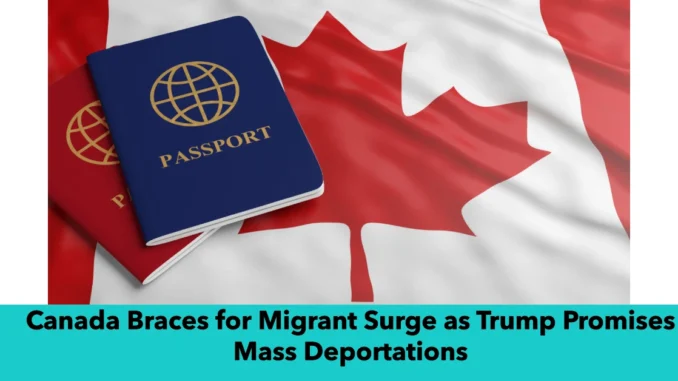
At 5,525 miles, the border separating the United States and Canada is the longest international boundary in the world. As this boundary becomes a focus of heightened scrutiny, particularly under the leadership of President-elect Donald J. Trump, tensions are rising. Canadian officials fear that Trump’s aggressive stance on immigration will drive a surge of migrants seeking refuge in Canada, while U.S. officials are increasingly concerned about undocumented crossings from Canada into the United States.
Potential Surge in Migrants
With Trump promising mass deportations, Canadian authorities are bracing for a possible increase in migrant crossings at the northern border. In anticipation, the Canadian government is rolling out new security measures and planning for the establishment of emergency reception facilities along the border between New York State and the province of Quebec. These efforts are aimed at managing what is expected to be a significant uptick in migration due to Trump’s hardline policies on deportation.
Growing Concerns from the U.S. Administration
The northern border is also attracting attention from key figures in Trump’s administration, including the newly appointed border czar, Tom Homan. He has expressed concerns that the U.S.-Canada border is a major security vulnerability, citing insufficient border checks as a growing risk for illegal immigration. The increase in undocumented migrants trying to cross from Canada into the United States has become a flashpoint in this debate.
Canada’s Changing Approach to Migration
The shift in Canada’s stance on immigration is notable, particularly when comparing the first and second Trump administrations. Under Prime Minister Justin Trudeau’s leadership, Canada openly welcomed asylum seekers and refugees, positioning itself as a sanctuary for those fleeing persecution and violence. This welcoming policy was in stark contrast to Trump’s immigration policies, which included family separations and restrictions on asylum seekers at the U.S. southern border.
However, the mood in Canada has evolved. Many Canadians now believe that the influx of migrants, particularly legal immigrants, has strained essential resources like housing. Provincial leaders, especially in Quebec, have voiced concerns about the growing pressure on local infrastructure, which has led to discussions on tightening immigration policies and reducing the number of legal migrants entering Canada.
Increased Enforcement Measures on the Border
In response to these concerns, Canadian authorities are preparing to fortify the border with increased patrols, more vehicles, and expanded detention and processing facilities. The Royal Canadian Mounted Police (RCMP) are gearing up to manage a possible surge in migrant crossings even before Trump officially takes office. The RCMP has identified additional enforcement agencies that could be called upon to reinforce border security.
Alongside these efforts, Canada is also utilizing the Safe Third Country Agreement with the United States, which allows both countries to send back asylum seekers who attempt to cross from one country to the other. This agreement continues to be enforced, even as the number of migrants crossing the northern border continues to rise.
A Surge in Border Crossings
The number of migrants attempting to cross from Canada to the United States has escalated significantly. From October 2023 to September 2024, U.S. Customs and Border Protection apprehended over 19,300 undocumented migrants at the U.S.-Canada border, a sharp increase compared to previous years. This surge has been particularly pronounced in areas like Quebec, New York, and New Hampshire, where more than 12,000 of the apprehended individuals were from India.
This rise in crossings has been fueled in part by social media, where online advertisements promote smuggling routes for Indian nationals seeking to enter the United States through Canada. These routes, often advertised on platforms like TikTok, promise to guide migrants across the border in exchange for significant sums of money.
The U.S. Response: Stricter Policies and Increased Border Control
In response to the growing number of illegal crossings, U.S. officials have adjusted their policies to expedite the deportation of migrants. A key change in U.S. policy has been the shortening of the window in which migrants can gather evidence for their asylum claims. Starting in August, detained migrants now have only four hours to find a lawyer and present their case, compared to the previous 24-hour period.
This stricter approach has led to a drop in the number of crossings, from around 3,600 in June to approximately 1,800 in September. However, the number of individuals returned to Canada has surged during this period, with over 400 migrants sent back between August and October 2024.
Political Pressure and Criticism
The increasing number of undocumented crossings has sparked criticism from Republicans, including Trump allies, who have accused Canada of not adequately controlling its northern border. Republican figures such as Congresswoman Elise Stefanik have referred to the surge in migrants as an “invasion,” further fueling tensions between the two countries.
Tom Homan, the newly appointed border czar, has echoed these concerns, describing the northern border as a “huge national security issue” for the United States. His comments reflect the growing political pressure to address the situation at the U.S.-Canada border and implement stricter immigration policies.
New Survey Reveals Growing Anxiety Among Canadians Regarding Immigration
Ontario Introduces New Legislation to Combat Immigration Fraud
Canada vs. Australia: Which is the Better Option for International Students Pursuing Immigration?
Student Discounts and Special Offers for International Students in Canada
Canada’s Tax System Requires Urgent Overhaul
International Students in Canada Can Now Work 24 Hours a Week Off-Campus: What You Need to Know
As tensions continue to rise over the U.S.-Canada border, both nations are grappling with the impact of immigration policies, security concerns, and changing public attitudes towards migration. Canada’s proactive measures, including increased border enforcement and the continued implementation of the Safe Third Country Agreement, are part of a broader strategy to address the challenges posed by increased migrant flows. Meanwhile, the United States is tightening its immigration policies in response to the surge in undocumented crossings, highlighting the ongoing friction between the two neighboring countries over border security and immigration reform.


Leave a Reply